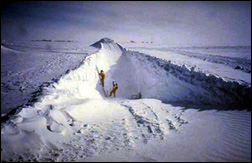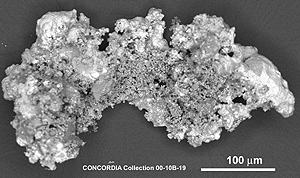|
Leonid MAC |
| home |
| View the shower |
| Mission Brief |
| Science Update |
| Media Brief |
| links |
LEONID DAILY NEWS: October 22, 2002
 Figure: Collecting meteoroid dust particles from snow layers in Antarctica.
Figure: Collecting meteoroid dust particles from snow layers in Antarctica.
In 1997, Jean Duprat and Michel Maurette of the University of Paris at Orsay (CSNSM) and coworkers in Denmark and England launched a long-term program to collect micrometeorites from historical Leonid showers in both Greenland and the Antarctic ice cap. The snow is melted layer by layer, thus collecting meteoric debris from specific years. In this way, Maurette et al. hope to find an increase of extraterrestrial dust in 1966 and from recent Leonid storms. Until now, 2 expeditions were executed in central Antarctica, at the station CONCORDIA-DOME C located at S75ÿý, E123ÿý. The experimental device is a stainless steel double-tank snow smelter (using a propane gas heater). The water is then filtered through 25 and/or 30 micron filters. The filters are then examined in the field in clean conditions with a binocular microscope. In January 2000 and January 2002 we collected samples from snow layers including the 1966 level to search for possible variations in intensity and/or composition of the micrometeorites flux. The analysis of the particles of extraterrestrial origin is in progress. The picture above was taken during the first expedition at CONCORDIA-DOME C in january 2000 and shows the trench from which the snow was recovered.
The picture to the left shows one of the micrometeorites collected from the antarctic snow. So far, no particles can be linked to the Leonid shower. With the help of Prof. Claus Hammer (NBI Copenhagen-DK), and the financial support of the Danish Research Council Dupras et al. are currently organising a new collect in central Greenland in june 2003. The main objective will be, if the 2002 storm is intense enough, to try to collect it in surface snow layers using the same technique we developed for Antarctic collects. Read more here. Oct 22 - Collecting meteoroid debris from snow cover Oct 21 - Highlights COSPAR/World Space Congress Aug 31 - First UV spectrum: Leonid from space 2001: Dec 11 - Shocking Leonid Dec 01 - Moon impacts Nov 26 - Near-IR persistent train emission Nov 24 - Results of near-real time flux measurements Nov 22 - Wowh! Optical meteor spectra 2000: Dec. 25 - Ursid shower circular IMO Dec. 24 - Ursid shows early release of sodium Dec. 23 - Ursid outburst confirmed Dec. 18 - Dec 22 Ursid outburst Nov. 20 - A bacterial fingerprint? Nov. 15 - HCN disappears mysteriously Nov. 14 - Meteor shower from space Nov. 13 - Organic fingerprint Nov. 12 - Train airglow chemistry Nov. 11 - Hard bits and persisting glows Nov. 10 - Meteoroid debris detected Nov. 09 - New meteor picture Nov. 08 - Spin city Nov. 07 - Meteors affect atmospheric chemistry Nov. 06 - Listen to this! Nov. 04 - Fear of heights? Nov. 03 - The pale (infra-red) dot Nov. 02 - Twin showers Nov. 01 - Leonids approaching Earth Oct. 31 - Prospects for Moon Impact Studies Oct. 30 - Comet dust crumbled less fine Today's news
| ||


